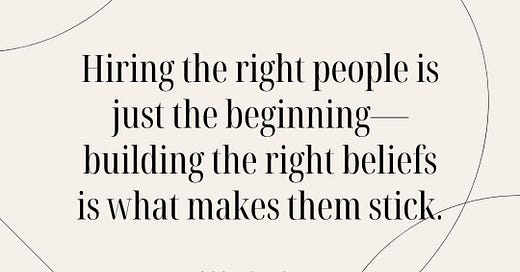If You’re Just Checking Boxes This Summer, You’re Missing the Most Important Work
More on summer and the work of developing shared beliefs
Ah, summer. A time that should be about reflection and rest, but for school leaders, it's often more of a juggling act between closing out one year and gearing up for the next. It's a strange, in-between season: the current year is winding down, but hiring season is knocking at the door, bringing all the usual headaches—staff changes, staffing gaps, and the pressure to hire the "right" people. And then, there's the talent game. It’s tough. The pressure to find the perfect fit feels like walking a tightrope.
For those of you leading a new team, this time can be particularly tricky. You’re onboarding new staff while still managing the chaos of the current year. Everyone’s figuring out where and how they fit in, and it can feel like a race against time. It's exhausting, messy, and often leaves you wondering if you're doing enough.
But amidst the hustle, there’s a crucial piece of the puzzle that needs attention now—before the whirlwind of next year begins. As you bring together a new team, it’s tempting to focus on tasks and checkboxes—who’s doing what, when things need to be done, and how fast you can get it all organized. But the real work starts with something more subtle, yet far more impactful: shared beliefs.
It's about taking time to get everyone on the same page about what truly matters and how you'll get there—together.
Onboarding and Flying the Plane
As you guide your new team through the school’s expectations and culture, you’ll find yourself making casual comments like, “Our kids really struggle with X” or “Ms. Johnson is really the culture of the school.” These throwaway lines aren’t just chatter; they’re your first crack at feedback and building the foundation of shared beliefs.
But how do you turn these “offhand” comments into something more meaningful? How do you translate these casual observations into guiding beliefs that will help form the norms for your team?
Creating Shared Beliefs: The Bridge Between Feedback and Team Norms
Start with a document—yes, an actual document where you can capture these moments of wisdom. As you and your team encounter these pieces of insight—whether it's your first observations of how your new staff operates or the subtle nuances of the school’s culture—write them down. This document becomes the raw material for your shared belief system.
For example:
If you say, “Our kids struggle with X,” ask yourself, What do we believe about this struggle? Maybe it’s: “We believe that every challenge faced by our students is an opportunity for growth, and that we, as a team, are responsible for finding solutions.”
Or when you say, “Ms. Johnson is really the culture of the school,” reframe it: “We believe that strong, consistent leadership is vital for a positive school culture, and we commit to embodying those leadership values every day.”
These statements aren’t just things you think. They’re the beliefs that will guide your actions.
These aren't isolated opinions; they become the foundation of the culture you’re building with your leadership team.
Be careful to manage the tension (see below).
Building Team Norms from Shared Beliefs
Take those belief statements and start building them into team norms. They are the how of your school’s culture, and they need to be articulated in a way that everyone on your team can reference, own, and live by. For instance:
If your belief is that all students can grow, then your team norms might include: Keep the bar high.
If you believe in consistent and transparent communication, your team norm might be: We will share feedback openly, constructively, and in real-time.
These norms need to live in your team’s daily work, not just in a mission statement you pull out during meetings. They need to be referenced regularly—whether it’s in an impromptu hallway chat or during a deep dive into a lesson plan.
When something isn’t working, you can come back to these beliefs to recalibrate. Ask: What do we believe about this issue? That’ll get you one step closer to solving it.
The Power of Collaboration: Study Yourself, Study Your Team
Use collaborative spaces—whether they’re meeting agendas or shared Google docs—to continuously refine and revisit your beliefs.
You’ll find that your team’s norms and beliefs will evolve over time. And that’s okay. That’s actually the goal. This document you’ve started will become a living, breathing piece of your work, something you refer back to and refine as you grow together. It’s the blueprint for the kind of team you’re building.
In a way, you’re always studying yourself and your team. What’s working? What isn’t? What do we believe about our struggles? About each other? About our students? And most importantly: What can we do, together, to make the work better?
As we head into the summer, straddling the realities of this year and the unknowns of the next, don’t let this moment slip by. Lean into the tension of this strange season. Gather your team’s wisdom, build shared beliefs, and when the time comes for those hiring decisions, those uncomfortable conversations, or the challenges that inevitably arise—you’ll have the foundation to move forward with clarity, strength, and collective purpose.
In the talent game, the best teams always win. Let’s make sure yours is one of them.
Need more on transitions?











